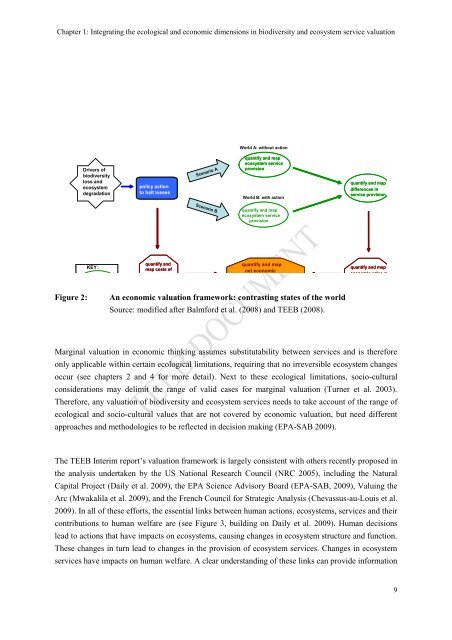Chapter 1 Framework of integration of ecology and economy ... - TEEB
Chapter 1 Framework of integration of ecology and economy ... - TEEB
Chapter 1 Framework of integration of ecology and economy ... - TEEB
You also want an ePaper? Increase the reach of your titles
YUMPU automatically turns print PDFs into web optimized ePapers that Google loves.
<strong>Chapter</strong> 1: Integrating the ecological <strong>and</strong> economic dimensions in biodiversity <strong>and</strong> ecosystem service valuationWorld A: without actionDrivers <strong>of</strong>biodiversityloss <strong>and</strong>ecosystemdegradationactionpolicy actionto halt lossesScenario Aquantify <strong>and</strong> mapecosystem serviceprovisionWorld B: with actionquantify <strong>and</strong> mapdifferences inservice provisionScenario Bquantify <strong>and</strong> mapecosystem serviceprovisionFigure 2:KEY:ECOLOGYECONOMYPOLICYquantify <strong>and</strong>map costs <strong>of</strong>actionquantify <strong>and</strong> mapnet economicconsequences<strong>of</strong> actionAn economic valuation framework: contrasting states <strong>of</strong> the worldSource: modified after Balmford et al. (2008) How does it<strong>and</strong> affect <strong>TEEB</strong> (2008).poverty? Equity? GlobalGDP? etcquantify <strong>and</strong> mapeconomic value <strong>of</strong>differences inecosystem servicesMarginal valuation in economic thinking assumes substitutability between services <strong>and</strong> is thereforeonly applicable within certain ecological limitations, requiring that no irreversible ecosystem changesoccur (see chapters 2 <strong>and</strong> 4 for more detail). Next to these ecological limitations, socio-culturalconsiderations may delimit the range <strong>of</strong> valid cases for marginal valuation (Turner et al. 2003).Therefore, any valuation <strong>of</strong> biodiversity <strong>and</strong> ecosystem services needs to take account <strong>of</strong> the range <strong>of</strong>ecological <strong>and</strong> socio-cultural values that are not covered by economic valuation, but need differentapproaches <strong>and</strong> methodologies to be reflected in decision making (EPA-SAB 2009).The <strong>TEEB</strong> Interim report‟s valuation framework is largely consistent with others recently proposed inthe analysis undertaken by the US National Research Council (NRC 2005), including the NaturalCapital Project (Daily et al. 2009), the EPA Science Advisory Board (EPA-SAB, 2009), Valuing theArc (Mwakalila et al. 2009), <strong>and</strong> the French Council for Strategic Analysis (Chevassus-au-Louis et al.2009). In all <strong>of</strong> these efforts, the essential links between human actions, ecosystems, services <strong>and</strong> theircontributions to human welfare are (see Figure 3, building on Daily et al. 2009). Human decisionslead to actions that have impacts on ecosystems, causing changes in ecosystem structure <strong>and</strong> function.These changes in turn lead to changes in the provision <strong>of</strong> ecosystem services. Changes in ecosystemservices have impacts on human welfare. A clear underst<strong>and</strong>ing <strong>of</strong> these links can provide information9
















